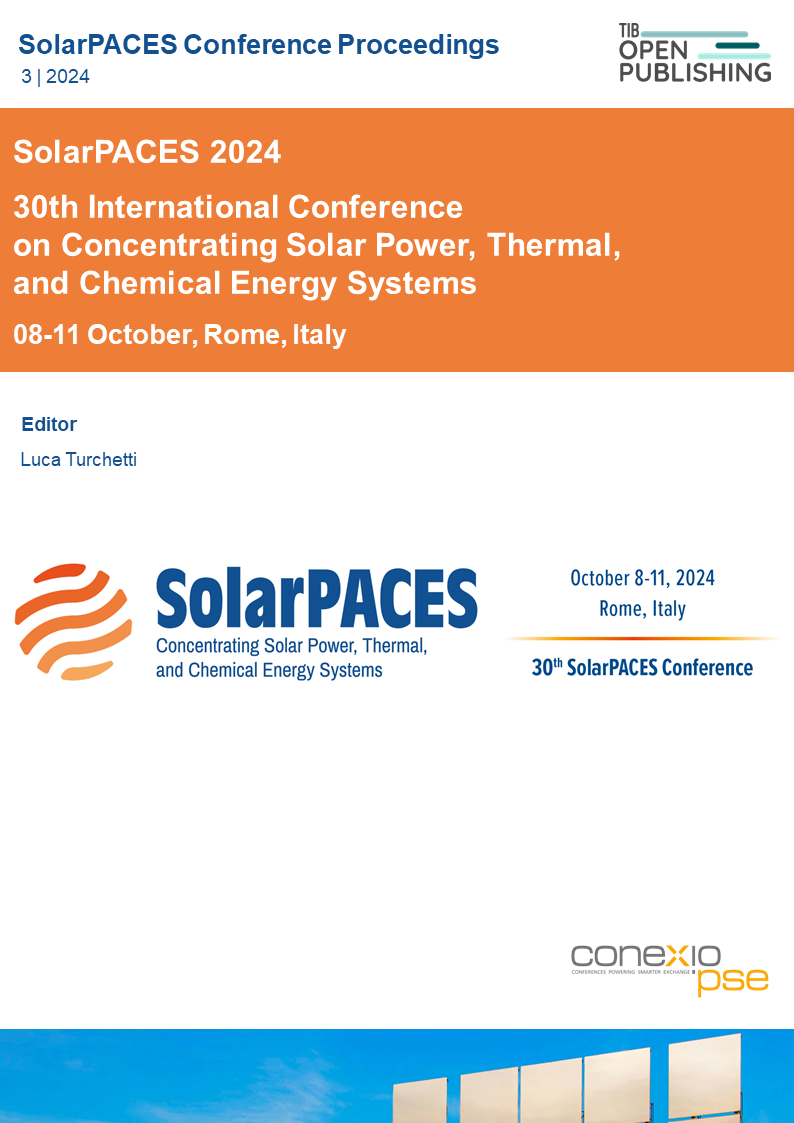Exergy-Based Crossover Salt Tank Protection
A Study on Safeguards for Critical CSP Components
DOI:
https://doi.org/10.52825/solarpaces.v3i.2325Keywords:
Concentrated Solar Power (CSP), Molten Salt, Temperature Gradients, Salt Tank ProtectionAbstract
In recent decades, renewable energy's share in global energy production has grown, with ambitious goals set for the green transition. Concentrating Solar Power (CSP) is crucial in this shift due to its energy storage and on-demand delivery capabilities, which prevent competition with intermittent sources like wind and photovoltaic (PV) systems. CSP enhances grid stability by providing energy during low production times and storing excess energy as heat. This stored heat, at high temperatures up to 550°C, can be used in industrial processes, including green fuel synthesis. The key components in CSP systems are the salt tanks, which are vulnerable to issues like corrosion, thermal shock, and thermal deformation, as seen in several projects worldwide. These issues are often due to temperature gradients in the tanks, which can cause buckling and fatigue rupture. The study focuses on strategies to minimize these risks, particularly through innovations in Vast's CSP v3.0 design. This includes a modular solar field arrangement to reduce temperature peaks and drops, active control of molten salt flow to match heat carrier fluid (HTF) temperatures, and a robust heat exchanger to buffer temperature changes. An innovative algorithm in the valve system at the molten salt tank inlets further enhances safety by directing hot salt to appropriate destinations, addressing the temperature differential issue that could reduce the equipment lifespan. This study, based on a numerical model of the entire plant and real weather data, tested various configurations to optimize the salt tanks' working conditions.
Downloads
References
[1] M. K. Patel et al., "The role of concentrated solar power (CSP) in achieving low-carbon energy systems," Renewable and Sustainable Energy Reviews, vol. 141, p. 110783, 2021. [Online]. Available: https://doi.org/10.1016/j.rser.2021.110783.
[2] S. M. Shah and J. D. Turner, "Performance Analysis of Electric Heaters for CSP Plants: Enhancing Flexibility and Grid Stability," Solar Energy, vol. 181, pp. 535-550, Nov. 2019.
[3] B. K. Sovacool and P. L. Gilbert, "The Limits of Steam Turbine Start-Up Flexibility and Ramp Rates: A Review of Critical Operating Parameters," Applied Energy, vol. 202, pp. 191-205, Sept. 2017. doi: 10.1016/j.apenergy.2017.05.083.
[4] S. Kraemer, ‘What happened with Crescent Dunes?’, SolarPACES. Accessed: May 03, 2024. [Online]. Available: https://www.solarpaces.org/what-happened-with-crescent-dunes/
[5] S. Kraemer, ‘Vast Solar’s fix for tank leaks that stymied the first Tower CSP’, So-larPACES. Accessed: May 03, 2024. [Online]. Available: https://www.solarpaces.org/vast-solar-has-a-fix-for-crescent-dunes-thermal-storage-tank-leak/
[6] Z. Wan, J. Wei, M. A. Qaisrani, J. Fang, and N. Tu, ‘Evaluation on thermal and mechan-ical performance of the hot tank in the twotank molten salt heat storage system’, Applied Thermal Engineering, vol. 67, DOI: https://doi.org/10.1016/j.applthermaleng.2019.114775.
[7] J.D. Osorio et al., 2024. Failure Analysis for Molten Salt Thermal Energy Storage Tanks for In-Service CSP Plants. Golden, CO: National Renewable Energy Laboratory. NREL/TP-5700-89036. www.nrel.gov/docs/fy24osti/89036.pdf. DOI: 10.2172/2331241
[8] R. Bradshaw et al., ‘Final Test and Evaluation Results from the Solar Two Project’, SAND2002-0120, 793226, Jan. 2002. doi: 10.2172/793226.
[9] J. Liu, Y. He, and X. Lei, "Heat-Transfer Characteristics of Liquid Sodium in a Solar Re-ceiver Tube with a Nonuniform Heat Flux," Energies, vol. 12, no. 8, 2019. doi: 10.3390/en12081432.
[10] P. Drosatos, G. Itskos, and N. Nikolopoulos, "Cross-Cutting CFD Support for Efficient Design of a Molten Salt Electric Heater for Flexible Concentrating Solar Power Plants," Energies, vol. 16, no. 17, pp. 6403, Sep. 2023. [Online]. Available: https://doi.org/10.3390/en16176403
Published
How to Cite
Conference Proceedings Volume
Section
License
Copyright (c) 2025 Fabio Aste, Kurt Drewes

This work is licensed under a Creative Commons Attribution 4.0 International License.
Accepted 2025-03-28
Published 2025-11-19
